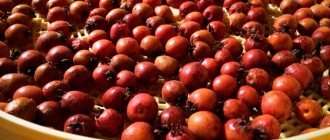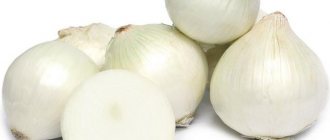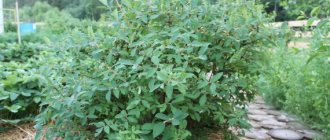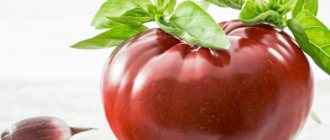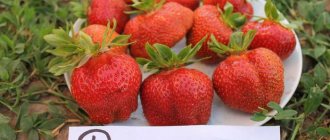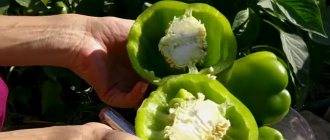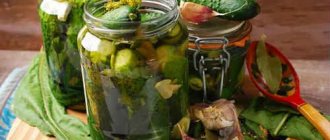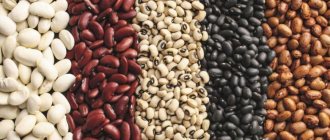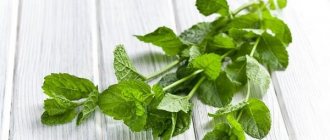Description of watermelon radish
Pink radish was bred by European breeders, but the vegetable gained great popularity among American chefs. Russian gardeners learned about the bright red root vegetable only in 2000.
Depending on the variety, watermelon radish can have a variety of shapes and colors of flesh. It can be flattened, oval and round. The color of the pulp is snow-white, lemon, red and purple. There are varieties with double color. The pulp is beautiful, juicy and sweet. The root vegetable got its name not because of its watermelon taste, but because of its original sweet pulp. Radish acquires a pronounced taste as it ripens.
Regardless of the variety, the size of the red radish does not exceed 8 cm. The skin of the watermelon radish is light olive in color. Thanks to the dense peel, the crop tolerates transportation well, but the shelf life of the vegetable does not exceed 2-3 months. To increase the shelf life, the crop should be stored in a cool room, since at room temperature, watermelon radish loses its presentation and sweet taste.
The leaf rosette is semi-erect, medium-sized, dark olive in color with jagged edges. The average weight of a root crop is 100-150 g.
Red radish is an early-ripening hybrid that can withstand weather changes and slight spring frosts. In regions with an unstable climate, seeds are planted under film cover in mid-April, and if agrotechnical rules are followed, the first harvest can be harvested after 35 days.
Watermelon radish is a high-yielding variety. Due to its rapid ripening, the crop can be harvested several times a season. The largest harvest is obtained in August, from 1 sq. m, subject to proper care, you can harvest from 8 kg of fruit.
Red radish is resistant to diseases and pests. But in order to avoid serious problems, it is necessary to carry out preventive measures in a timely manner: watering by sprinkling, removing weeds, loosening the soil.
Important! Watermelon radish does not develop in high air humidity, so in regions with rainy summers it is recommended to grow the root crop under a film cover.
To appreciate the beauty of red radish, you need to look at the photo, but to get an idea of the taste, it is advisable to grow watermelon radish in your garden.
Medicinal properties
Any radish is rich in vitamins, especially a lot of ascorbic acid and vitamins B and C. It contains a large amount of fiber and organic acids, phytoncides and essential oils. In addition, when it is eaten, the human body receives such important substances as calcium, potassium, iron, phosphorus, magnesium, etc. Radish contains more of these microelements than many other vegetables.
The beneficial properties of the root vegetable have long been used in folk medicine. The fresh vegetable has an effective anti-inflammatory and expectorant effect, so it is used to treat coughs and other colds. Radish is indispensable for the body in the off-season. The vitamins contained in the vegetable improve the body's defenses and increase resistance to various infections. The root vegetable has the ability to preserve the necessary nutrients all year round, so in the spring, during the period of vitamin deficiency, consuming the vegetable will replenish the vitamin deficiency. The black variety is effective even against diseases such as pneumonia and bronchitis.
Since ancient times, the beneficial plant has been mixed with honey, resulting in a unique healing mixture. To do this, the plant was grated or chopped and the juice was squeezed out. Approximately 100 g of honey was added to one glass of juice to remove the bitterness from the resulting medicine. A similar recipe is still relevant today. Some people make it even simpler: take half the core out of the radish and pour honey into it, let the product brew a little, and then take a teaspoon as a medicine several times a day. The only contraindication is an allergy to bee products.
The beneficial properties of the plant are indispensable for the normal functioning of the digestive system. The only exceptions are black varieties. Substances in the vegetable suppress the development of pathogenic bacteria, remove waste and toxins, and stimulate fat metabolism, which is useful for overweight people and those who want to lose weight. When you eat radish in salads and other dishes, your appetite increases and the production of gastric juice, which is necessary for the normal absorption of food, increases.
The minerals in the plant are an excellent preventive measure for cardiovascular diseases. Vitamin C strengthens the walls of blood vessels and increases their elasticity, promotes the complete absorption of iron into the blood. Also, when eating vegetables, cholesterol levels decrease. Lotions and compresses from the juice of the plant with the addition of honey, salt and alcohol are used to treat rheumatism, gout, radiculitis and other diseases. And vegetable juice is also an excellent diuretic.
Useful properties of watermelon radish
Pink radish has many beneficial properties. The pulp contains vitamins, micro- and macroelements, mustard oil, glycosides and acids. Due to the increased content of dietary fiber and potassium, watermelon radish benefits the body.
Red radish is recommended:
- to restore the body after winter;
- for gastrointestinal diseases;
- to restore tone;
- to improve appetite;
- to strengthen the walls of blood vessels and heart muscle;
- to reduce body weight, since 100 g of product contains about 20 kcal.
Important! It must be remembered that red radish brings not only benefits to the body, but also harm.
Watermelon radish should be used with caution for gastritis, colitis and peptic ulcers during exacerbation. Pregnant and breastfeeding women also need to be careful. Before consuming radish, it is better to consult a specialist.
Chemical composition
The root vegetable is rich in substances that are of particular value to the body: potassium, calcium, sodium, valuable iron, phosphorus, copper, magnesium, important vitamins: A, B, C, H.
We invite you to read: Kiwi - beneficial properties and contraindications
| Nutritional value (gr.) | Vitamins (mg) | Macronutrients (mg) | Microelements (mg/kg) |
| Carbohydrates 6.7 | A (retinol) 0.02 | iron 1.2 | Mn 0.92 |
| Proteins 1.9 | B1 (thiamine) 0.03 | potassium 357 | Mo 0.07 |
| Fats 0.2 | B2 (riboflavin) 0.03 | calcium 35 | Cu 0.25 |
| Dietary fiber 2.1 | B3 (niacin) 0.2 | magnesium 22 | Zn 2.44 |
| Calories 34.5 | B6 (pyridoxine) 0.06 | sodium 13 | Co 0.21 |
| C (ascorbic acid) 29 | phosphorus 26 | Cr 0.29 | |
| PP (nicotinic acid) 0.3 | Se 0.05 | ||
| Li 0.02 | |||
| V 0.03 | |||
Varieties of red radish
Depending on the place of breeding, red radish is:
- European;
- Chinese;
- Japanese.
Despite the fact that Russian gardeners began to grow watermelon radishes relatively recently, they already have popular and favorite varieties.
Red heart
Red Heart is a Chinese hybrid with soft olive, dense skin. The pulp of the root vegetable is bright pink, juicy and sweet. There is no bitterness due to the reduced mustard oil content. The vegetable can be stored for a long time and is easily transported.
Chinese red radish contains vitamins, micro- and macroelements that have a beneficial effect on the functioning of the stomach, intestines and cardiovascular system. It is also recommended for cleansing the body and losing weight due to its low calorie content. The “Red Heart” variety should be consumed with caution by pregnant women, as the oils contained in the pulp tone the uterus and can cause a miscarriage.
Red Meath
The variety was bred by Japanese scientists. In terms of taste, the root vegetable resembles the famous Daikon variety. Red radish has large fruits, weighing about 300 g. The root vegetable is round or oval in shape, with a thin peel and dark pink flesh. Regardless of the cooking method, the fruits are not bitter, have a sweet taste and a delicate aroma.
The pulp contains dietary fiber, vitamins, macro- and microelements. 100 g of product contains no more than 35 kcal, so the variety is also recommended for use by people with excess body weight.
Pink glitter
A variety of red radish with pink, juicy flesh and a sweet taste. The ripe root crop reaches up to 10 cm in length. Mid-season, round fruit, with good taste and long shelf life. The variety is cold-resistant, so the crop can be harvested after the first frost.
Subject to agrotechnical rules, it produces a consistently high yield, which will become a decoration for the table.
Red winter
Red winter radish is a mid-early variety. From the appearance of sprouts to the harvesting of root crops, no more than 60-80 days pass. The root vegetables are large, weighing 200-300 g, round in shape, with good taste. The peel is dense, burgundy in color. The white pulp is dense, tender, sweet and without bitterness.
For summer use, seeds are sown in early spring under a film cover, for winter storage - in the first half of July. The variety is recommended to be consumed fresh, stewed, and is also used for preparing preserves for the winter. Due to the high content of vitamins and nutrients, red radish can be used for baby food.
Planting and caring for red radish
Watermelon radish is an unpretentious crop; in order to grow a rich harvest, you must follow simple care rules. They consist of watering, fertilizing and timely loosening of the soil. Also, preventive measures against diseases and insect pests play an important role in good growth and development.
Landing dates
To restore the body after winter, red radish can be planted in mid-April in a greenhouse or in early May, after the soil has warmed up, in open ground. Fruit harvesting begins a month after sowing the seeds. In order to always have root vegetables with vitamins in stock, sowing is done at intervals of 15-20 days.
Selection and preparation of a landing site
Before growing radishes with a red center, you need to choose the site wisely and prepare the soil in the fall. The culture develops well in partial shade, since in the open sun the plant will quickly begin to shoot arrows, and the root crop will stop growing and developing. It is better to plant radishes after legumes, cereals, tomatoes, potatoes and cucumbers. Experienced gardeners do not recommend planting watermelon radish after cruciferous vegetables, carrots and beets.
To grow a generous harvest, you must follow simple rules for preparing the planting site:
- watermelon radish grows well on loamy and sandy soil;
- the acidity of the soil should not exceed 7 Ph; if the acidity exceeds the permissible values, the soil is deoxidized with slaked lime or dolomite flour;
- high yields can be obtained on loose, nutritious soil;
- an excess of organic fertilizers will lead to growth of the above-ground part to the detriment of the mass of the root crop;
- if the dacha plot is small, and it is impossible to allocate a special bed for sowing, then red radish can be grown among other vegetable crops.
The bed for planting seeds is prepared in the fall. To do this, dig up the selected place and add humus, rotted manure or compost, as well as phosphorus-potassium fertilizers. The prepared area is covered with a 15 cm layer of mulch or black agrofibre for the winter.
Landing rules
Red radish is planted by seedlings and seeds directly into open ground. Before planting, you need to correctly select and prepare the seed.
When purchasing seeds, it is better to choose large specimens, as they produce a rich harvest of juicy root crops. For rapid germination and formation, the seed is soaked for 24 hours in cold water.
Seedlings
To get an early harvest, watermelon radishes can be grown in seedlings. To do this, the seeds are sown in flower boxes with fertile soil at intervals of at least 3 cm. The planting depth should be no more than 5-6 cm.
Cover the container with plastic wrap and put it in a dry, dark place. After the sprouts appear, the shelter is removed and the seedlings are transferred to the brightest place. Watering is carried out as the soil dries; fertilizing is not applied when growing seedlings.
Important! When 3-4 true leaves appear, the seedlings can be transferred to a permanent place.
Seeds
Watermelon radish can be grown from seeds in open ground and in greenhouse conditions. Radishes are grown in greenhouses in regions with rainy summers or in the first months of winter. Technique for growing red vegetables in a greenhouse:
- The soil must be moist and fertilized before planting.
- Seeds are sown at intervals of 3 cm, to a depth of 5-6 cm.
- For good growth and development, the temperature in the greenhouse should be 20-25 °C.
- If there is a lack of sunlight, artificial lighting is installed above the plants.
- Watering should be plentiful, once every 10-15 days.
- To protect the plant from freezing, hilling is carried out.
Sowing seeds in open ground is carried out only after the soil has warmed to + 10 °C. In the prepared bed, grooves are made 4-6 cm deep with an interval of at least 15 cm. Place 0.5 tsp in the prepared hole. azophoska, sprinkle with earth and place 2-3 seeds. The distance between the holes is maintained at 15-20 cm. After sowing, the soil is shed generously and the bed is mulched to retain moisture. After 3-4 true leaves appear, the seedlings are thinned out, leaving the strongest and healthiest.
Despite the fact that watermelon radish is an unpretentious crop, timely care must be observed to obtain a good harvest.
Loosening and weeding
Weeding and loosening are carried out every 5 days after emergence. This procedure will provide the root system with oxygen, eliminate the earthen crust and promote rapid growth of the vegetable. And timely removal of weeds will be a good prevention against insect pests and diseases.
Watering and fertilizing
Watermelon radish does not need frequent feeding. The first mineral complex of fertilizers is applied after the appearance of 3-4 true leaves; repeated feeding is carried out 30 days after the first.
The red vegetable is a moisture-loving crop; with enough water, the harvest will be plentiful, and the pulp will be sweet and without voids. Also, if you follow the watering rules, the plant will not form an arrow, and the fruits will grow juicy and sweet. Rules for irrigating watermelon radish:
- excess moisture leads to rotting of root crops and the addition of fungal diseases, so watering is carried out taking into account weather conditions;
- if there is a lack of liquid inside the vegetable, voids form;
- in hot weather, irrigation is carried out once every 7-10 days, per 1 square. m consume at least 10 liters of warm, settled water;
- if regular watering is not possible, then the bed can be covered with a 15 cm layer of mulch or non-woven covering material.
When growing red root vegetables, gardeners may encounter some difficulties:
- Root rotting occurs when there is an excess of moisture.
- The vegetable grows and develops poorly - the seeds are planted in heavy, clay soil or the plant does not have enough lighting.
- The fruits are small and bitter - long daylight hours.
- Bolting and flowering occurs when vegetables are grown in acidified soil and with insufficient watering.
- Cracking of the root crop is due to lack of liquid.
Health Benefits of Red and Other Vegetables
Is it good for children?
The vegetable has a lot of useful properties!
- Due to the iron and calcium content in green radish, it helps strengthen teeth and bones.
- If a child loves this variety, then rest assured that his immune system is well protected.
- Black radish improves appetite and has an antitussive effect.
- The root vegetable will save the restless mischief maker from bruises and contusions.
- Red radish boasts a high fiber content, which normalizes intestinal function (toxins are removed from the body).
What is good for women?
The benefits of red root vegetables for women are as follows::
- Red and black radishes relieve swelling by regulating the water-salt balance.
- In addition, the vegetable rejuvenates the skin, gives it elasticity and smoothness; the condition of hair and nails improves.
- Black radish juice prevents the occurrence of gynecological diseases and has a general strengthening effect.
- Green radish lowers sugar levels and is great for your diet.
- In moderation, the root vegetable can increase breast milk production.
For men
- Draikon radish prevents baldness and eliminates dandruff.
- The root vegetable also removes cholesterol and strengthens blood vessels.
- Black radish has a positive effect on the genitourinary system and fights prostatitis.
- The vegetable improves intestinal function, and if you regularly consume black radish, you can increase testosterone levels.
- Red radish cleanses the gallbladder and dissolves stones.
Diseases and pests
Watermelon radish is resistant to diseases and pests. But if agrotechnical rules are not followed, plants can be affected by the following diseases:
- When grown in acidic soil, the plant often suffers from viral clubroot. When infected with a virus, the fruits are modified, the pulp acquires a rigid structure and becomes inedible. If the soil on the site is highly acidic, then slaked lime or dolomite flour is added when digging.
- With strong moisture, fungi appear on the plant, affecting the above-ground parts and root crops.
- In hot, dry summers, cruciferous flea beetle and cabbage fly may appear on radishes. You can get rid of pests with onion or garlic infusion, as well as dusting with wood ash. Treatment is carried out in dry weather, in the morning.
Cruciferous flea beetle
Cabbage fly
Harvest and storage
When growing watermelon radish, you need to harvest the crop in a timely manner and store it properly. Root crops are collected a month after seed germination, since overripe fruits lose their marketable appearance, and the pulp forms voids and becomes less juicy and sweet.
Important! To ensure that the harvest is stored for a long time, harvesting is carried out in dry weather in the morning or evening hours.
After harvesting, the vegetables are left in the garden to dry. Next, the harvest is sorted, removing fruits with mechanical damage, since such specimens are not subject to long-term storage. After sorting, the tops are cut to 2 cm. The prepared vegetables are laid out in boxes, each layer is sprinkled with sand or ash and placed in a dry, cool, well-ventilated room. The shelf life of the crop is about 2-3 months.

